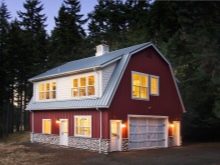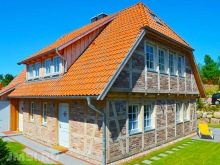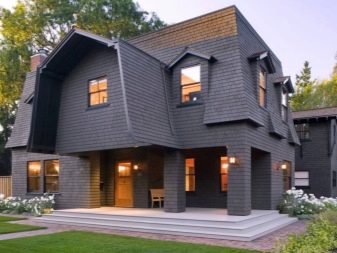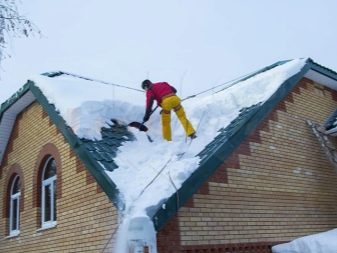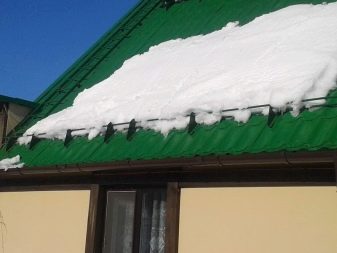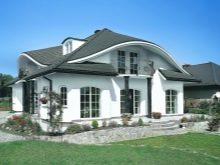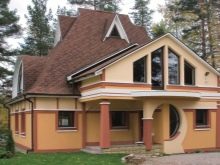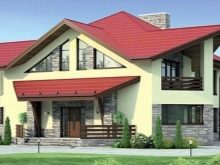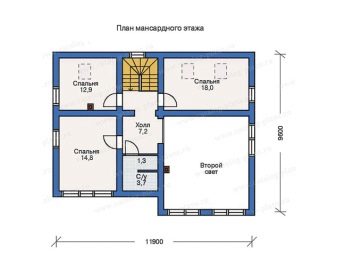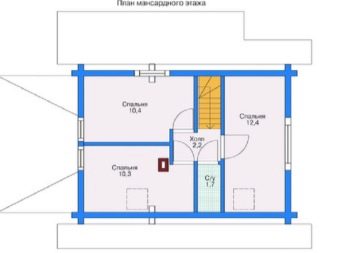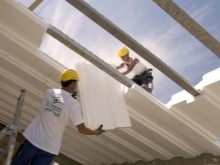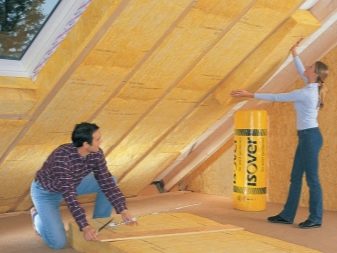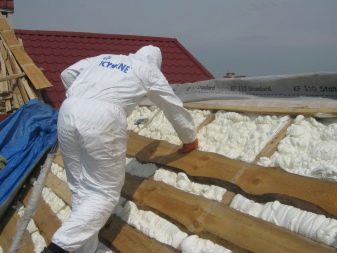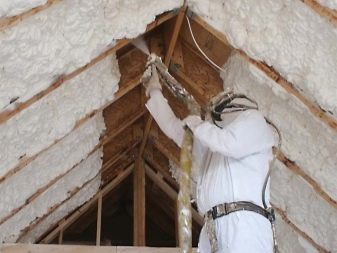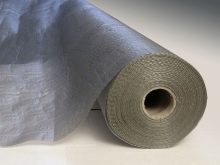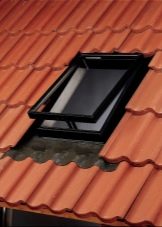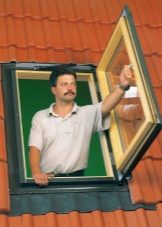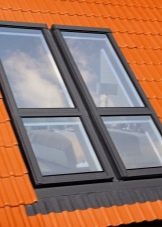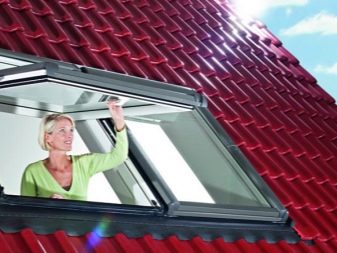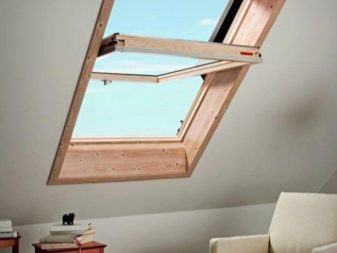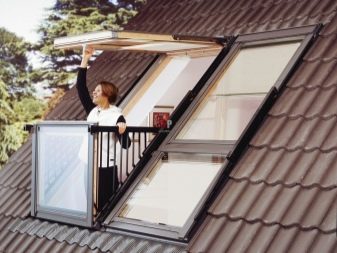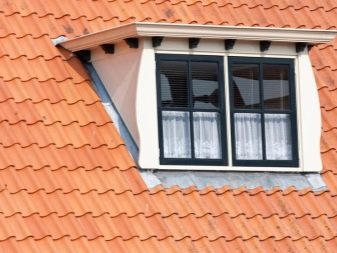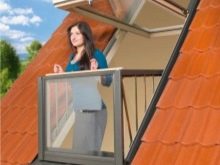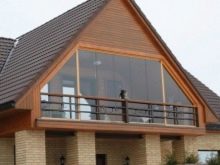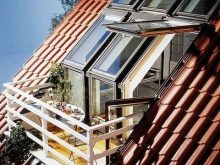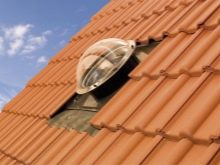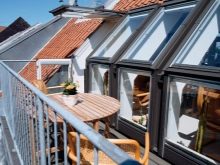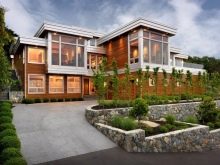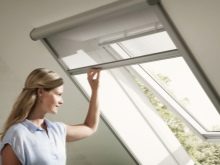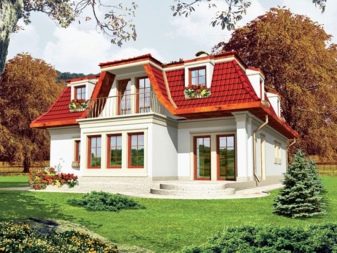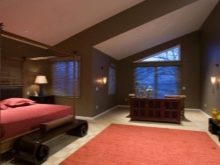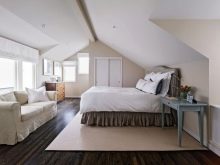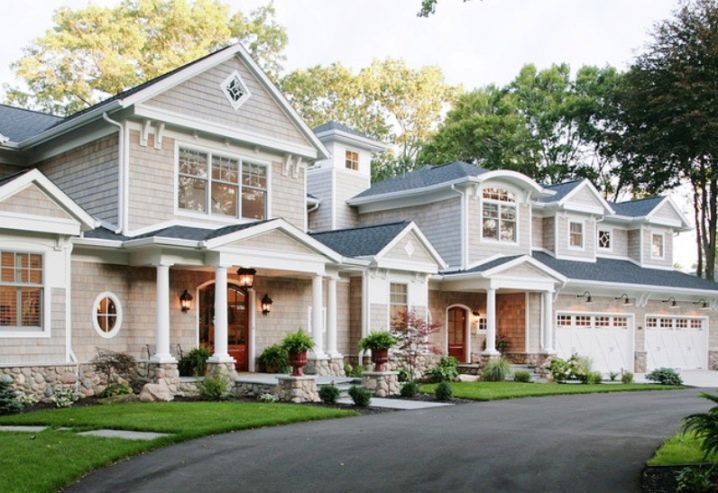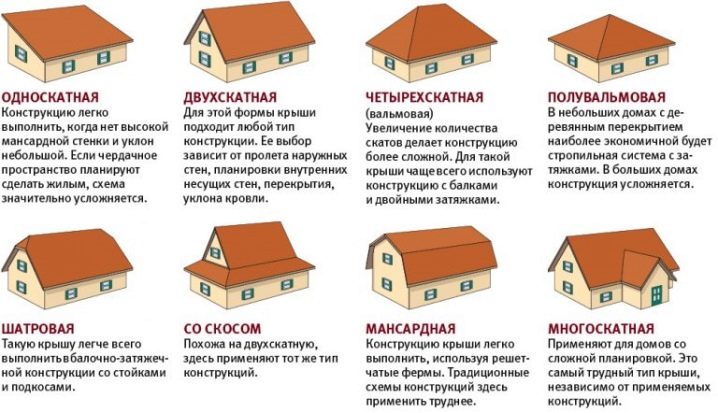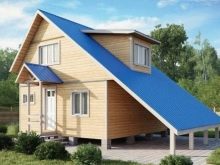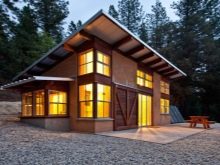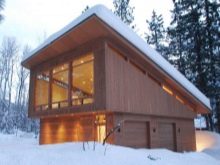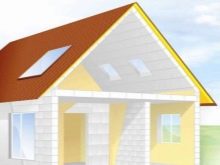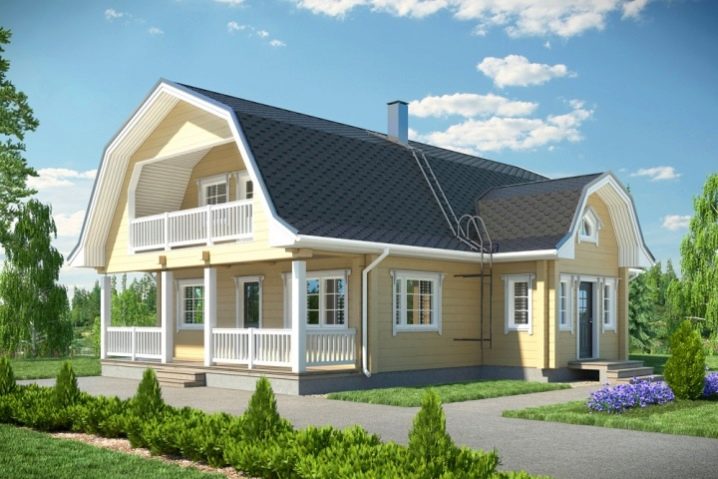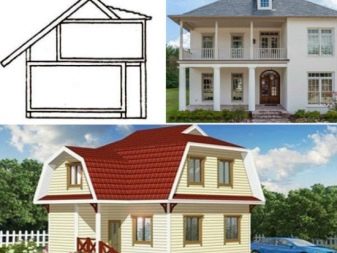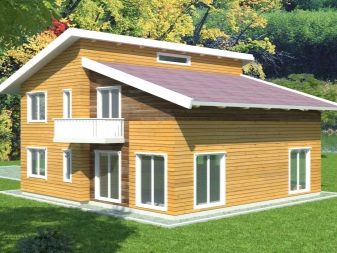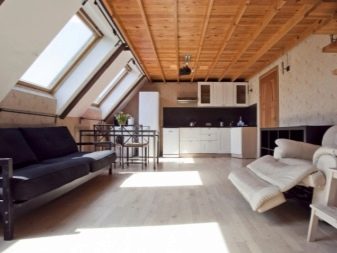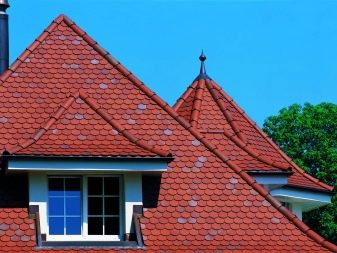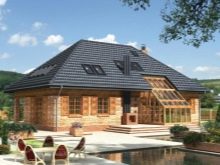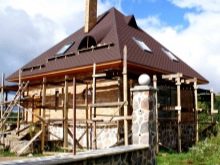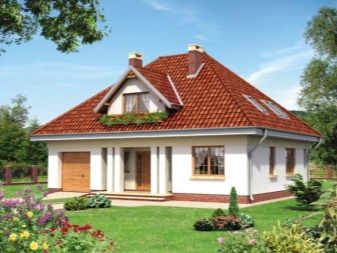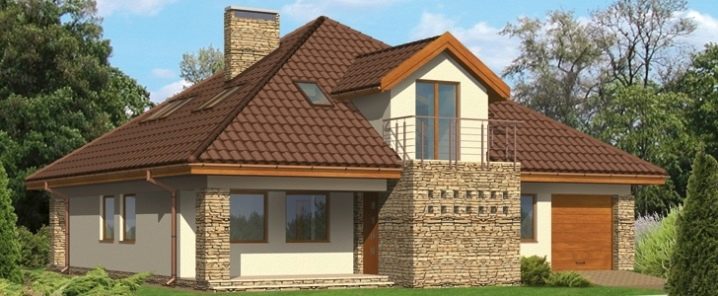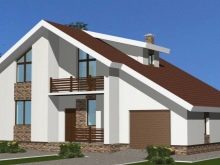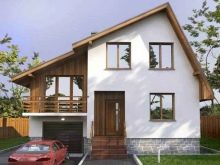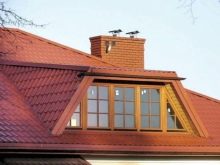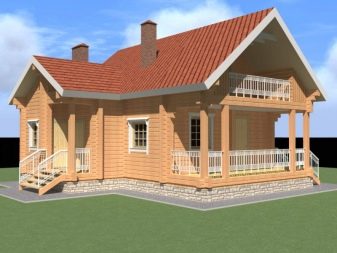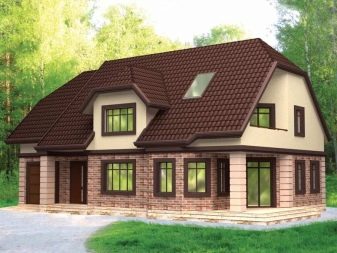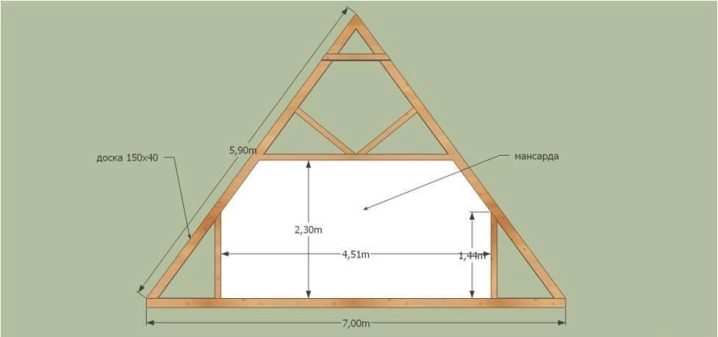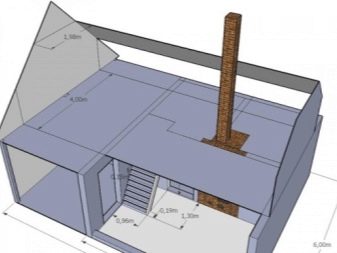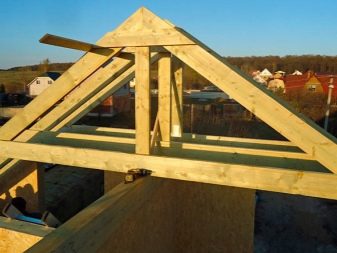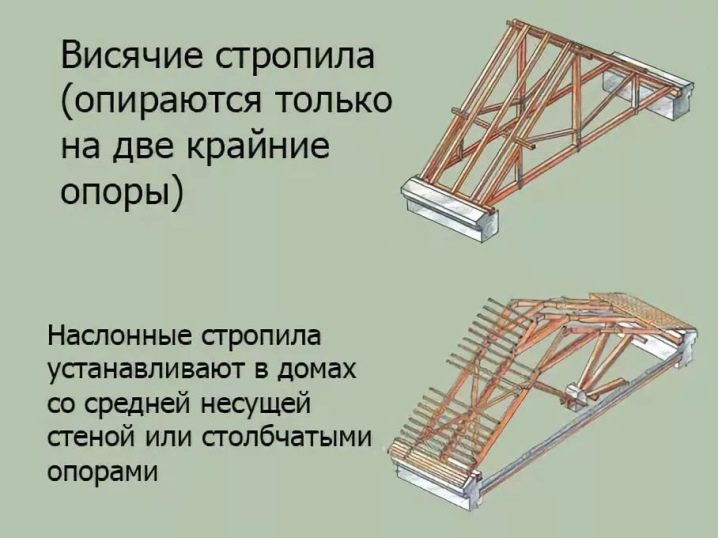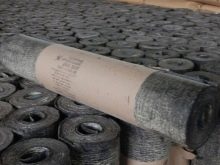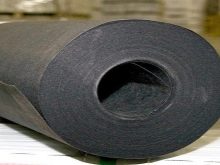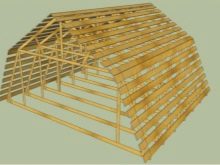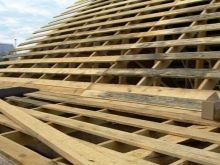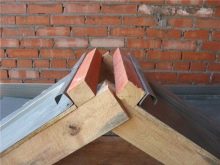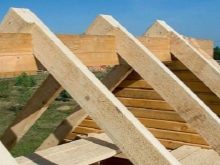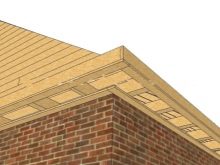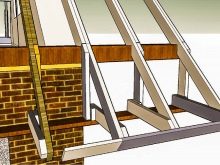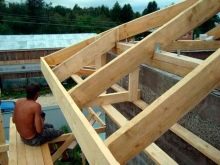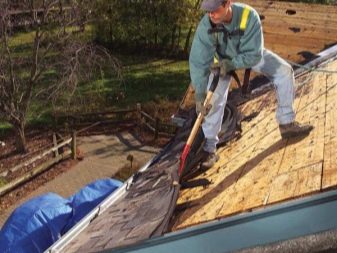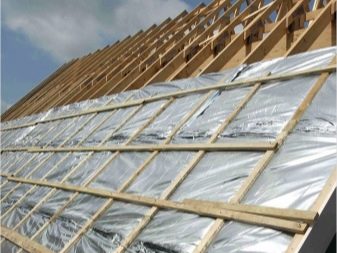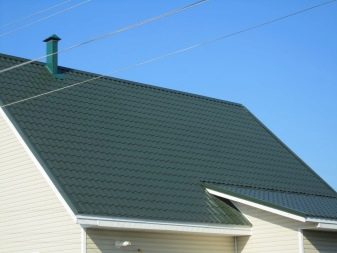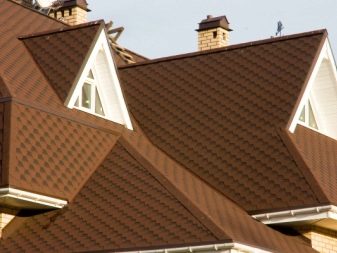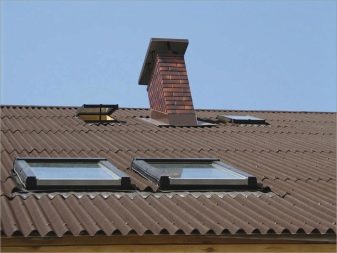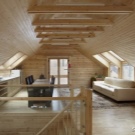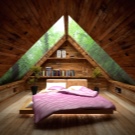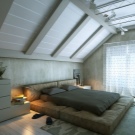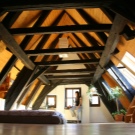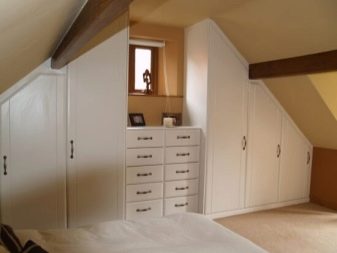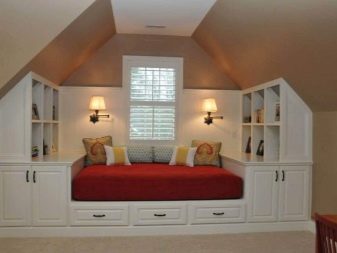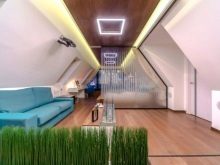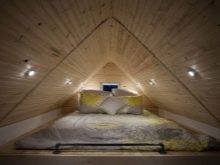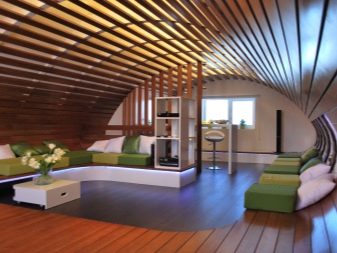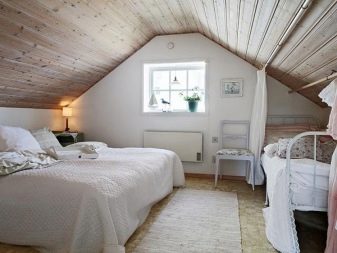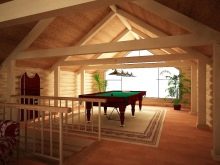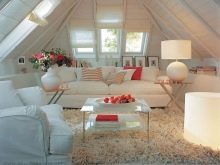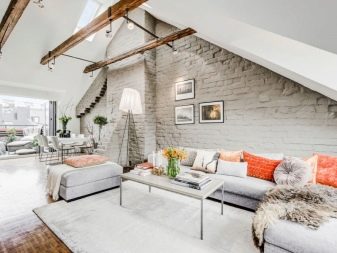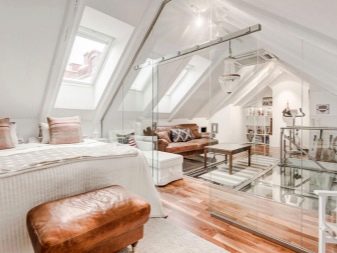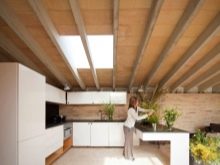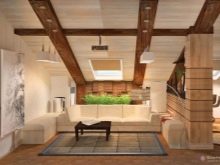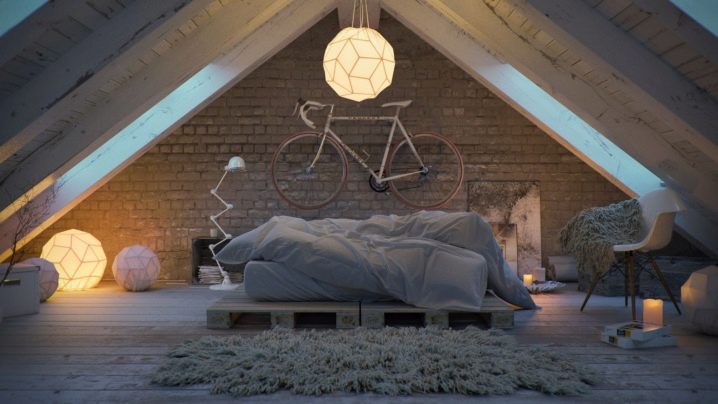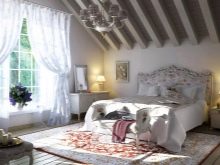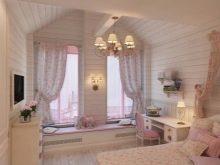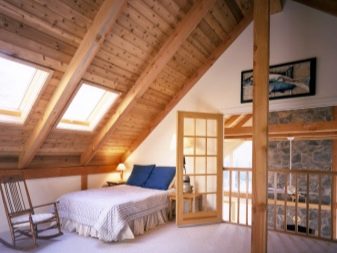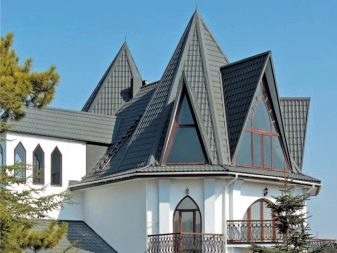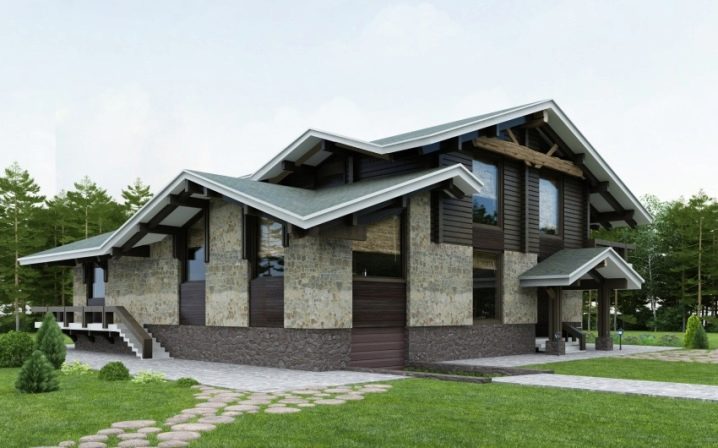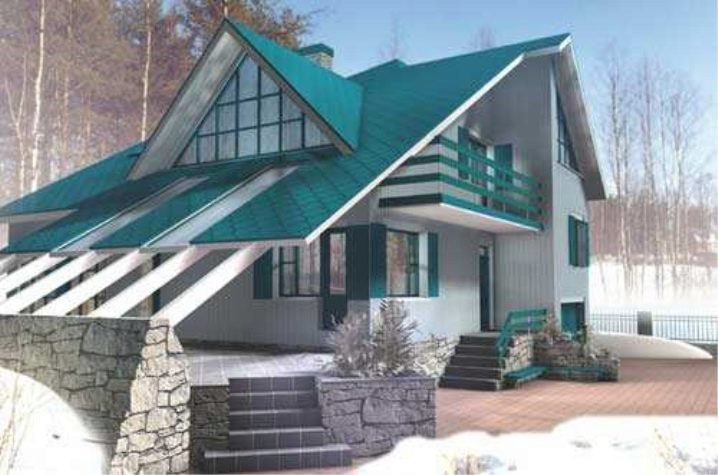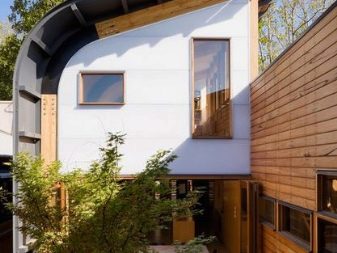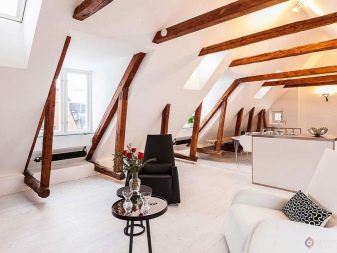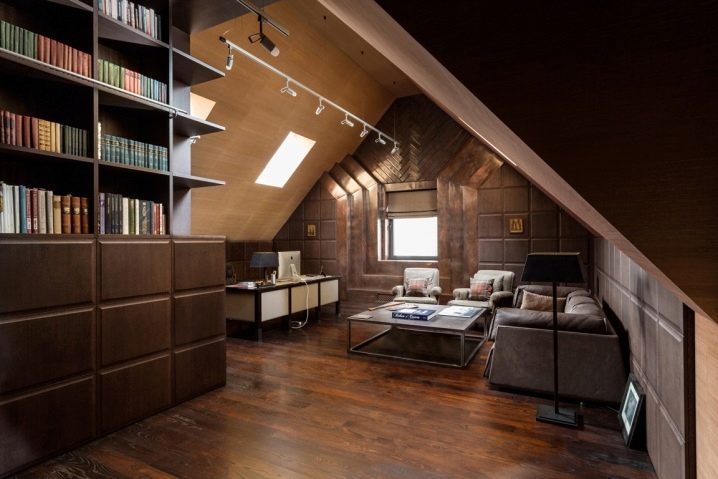Mansard roofs: types and features of structures

Surely, sooner or later, every owner of a private house comes up with the idea of arranging an attic roof - the so-called attic. It allows you to expand the space of the building, thereby preserving the cherished meters of the site itself. In addition, if you show a little imagination in the construction and decoration of this part of the house, the unusual and attractive look will delight not only guests, but also passers-by. How to correctly combine all the safety requirements of the construction and the individual design intent can be found in this article.
What it is?
Many people associate the image of the attic with the bohemian creative life of Paris, whose representatives - writers, musicians and artists, lived on the uppermost low-lighted and unheated floors. In the literal sense, these were business premises that only the poor could afford.
Today, the presence and design of the attic roof speaks about the welfare and sense of taste of the owner. The architectural geometry of the roof, unusual combinations of window openings and balconies will not only distinguish the private house from others, but also will functionally increase the living space, eliminating the cost of another floor.
Also, the room can affect the reduction of heat loss of the building. Officially, according to all standards, the attic must have a height of at least 2.5 m from the floor level, otherwise it will be considered an attic.
When building a mansard roof in Russia, one should be aware of the peculiarities of the natural conditions - rather cold winters with frequent temperature changes require special attention to the quality of insulation of the mansard room.
Features of the device
Features of the construction of the attic oblige to adhere to some rules:
- soundproofing;
- reliable insulation and vapor barrier;
- lack of stretch marks and bevels;
- ventilation gap;
- functional and aesthetic combination with the overall exterior of the house.
At the same time, compliance with all the rules does not limit the choice of the version of various designs of the structure itself: single, double, sloping, two-level, conical roofs, with or without balconies, mid-turn or balcony skylights. There are many variations. For reliability and safety, it is important to choose the type of roof, calculate the size, the number of materials insulation and roofing.
Comfortable living in the attic is directly dependent on thermal insulationwhich allows you to enjoy the light coolness in summer and keep warm in winter. Consider the method of laying the "pie" mansard roof, which will serve not only as a heater and the base of the roof, but also protects all surfaces inside the attic floor - the ceiling, floor and walls - from the insulation of the room. It is important to pre-plan the attic with all communications and an indication of the thermal conductivity of the materials from which the building and the bearing surfaces were erected. Only after this is the selection and calculation of insulation.
Particular attention should be paid to the indispensable presence and exact sequence of each layer of the “tart” of attic insulation:
- vapor barrier layer;
- insulation;
- ventilation gap;
- waterproofing material;
- roofing.
In this list, the layer of insulation and ventilation is particularly important. The following materials can be used as insulation.
Styrofoam
The modern demanded material possessing low density, but at the same time high durability. Differs in soundproofing, resists corrosion and does not attract dust. However, a significant drawback is the high flammability and the release of toxic substances. If you dwell on this insulation, then the foam layer should be fenced at least 3 cm of the fire-resistant structure, for example, a two-layer drywall. In addition, the foam is exposed to rodents.
Mineral wool
The most common material for warming the attic. Among its characteristic features - resistance to temperature extremes, fire safety, high sound and heat insulation, harmless from an environmental point of view. It can be purchased in the form of a roll, plate or mat.As an attic heater, the latter are recommended. The material certainly needs good ventilation.
Polyurethane foam
The main advantages are durability, long-term use, non-susceptibility to moisture, mold, suitable for any surface, non-toxic. But behind all the advantages lies the high cost and the work of exclusively specialists with the equipment.
It must be remembered that the thickness of the insulation layer is determined depending on the climatic zone.
To warm the attic will need:
- waterproofing film;
- insulation material;
- vapor barrier;
- mounting tape;
- cord (nylon);
- nails;
- hammer;
- pliers;
- sharp knife.
Thermal insulation of the room is directly related to the quality, type and size of the attic windows, their designs are usually placed between the rafters of the roof to avoid costly renovations. Therefore, in choosing it is important to be guided by the available dimensions. Among other things, you need to take into account the height of the slopes, the total area and purpose of the room.
78x118, 78x140, 78x160 cm and more enlarged - 94x140, 114x118 and 114x140 cm are considered to be the standard dimensions of the attic windows.
In that case, if the rafters are installed closer to the established standards of frames, it is likely that you will need to make a window to order, which, of course, will affect the costs.
According to the method of opening dormer windows are divided into:
- turning constructions;
- with side axle;
- raised axis of rotation;
- with the lower axis;
- the combined axis, allowing to turn a shutter on 180º.
The most popular option among Russian summer residents is with the central axis of the turn. As advantages - convenience in operation (such windows are easy to clean).
A separate version is represented by windows on the remote control, which will be convenient if the location does not allow them to reach them on their own. They are often equipped with rain sensors.
Depending on the model, there are several types of windows.
- Vertical. Mounted in a special so-called attic "birdhouse", because of which you have to slightly change the roof structure. However, a large amount of light is guaranteed.
- Balcony mansard. They are two doors, with the opening of which one rises, the lower one moves forward, forming a miniature parapet.Just like the previous model, they are expensive.
It should be noted that with the possibility of bearing walls, you can make a hanging balcony, which can be located either on the columns, employees and decoration in front of the entrance, or move the gable (part of the end wall between the roof slopes and the eaves) of the attic floor from the bearing wall, and the roof of done by continuing the roof to the level of the outer wall.
- Extensions. Decorative top window elements. Fit perfectly into the design and most often have a round, semicircular or triangular shape.
- Light tunnel. It combines a reflective tunnel into the room and the ceiling directly in the room itself, which evenly diffuses the light.
- Curtain models. They are located at right angles between the wall and the roof.
- Glazed bay window. Pretty exotic and expensive glazing model. The design extends beyond the wall plane.
Leading Russian manufacturers of high-quality roof windows - Velux, Fakro, Roto. Velux models are a bit more expensive. For example, a 78 cm window will cost 21-24 thousand rubles, wider - from 26 thousand.
Also do not forget about some additional useful accessories:
- blackout curtains;
- shutters, blinds;
- heat absorbing mesh;
- mosquito nets.
According to the established standards, the glazed area should be at least 10% of the floor area.
Advantages and disadvantages
The advantages of the attic floor can rightly be considered:
- Efficiency. Attic reduces the cost of heating the room. The air space between the floor and the ceiling of the attic space does not allow the generated heat to escape through the roof. The low thermal conductivity of air allows for the preservation of more heat on the ground floor.
- Obvious and savings on the construction of another floor or increase in living space due to the expansion of the foundation. Attic allows for a constructive additional space at minimal cost.
- Aesthetic appeal. Undoubtedly, the attic with the complexity and expressiveness of the roof gives the building a harmonious, architectural and finished look.
- Construction speed Such an extension will not last for several years, as often happens with the expansion of the foundation.Installation can be completed within a week.
In addition to the advantages, there are disadvantages.
- Saving on heating and replacing the second floor with an attic will later turn into a pretty penny. The room provides for the installation of specialized windows, which are much more expensive than usual.
- Sloping ceilings reduce the height of the walls.
- The vulnerability of the structure is due to the fact that the attic takes on all the main "blows" of nature, and therefore requires increased attention and periodic inspection. If necessary, repair or replacement of insulation does not avoid damage to the finish along with the vapor barrier.
- A complex coal roof leads to the formation of difficult-ventilated areas, which adversely affects the quality of the coating.
- Individual requirements for hydro and thermal insulation.
Problems that can be encountered in the construction of the attic:
- the use of untreated flame retardants and antiseptic lumber can lead to wood rot and the appearance of parasites;
- leaks in one layer of the “pie” before laying the next;
- too light and unsuitable overlap;
- attic equipment with already laid roof;
- Poor steam and waterproofing can cause rotting of the window slopes or the inner lining of the attic.
Types of designs
Undoubtedly, the ideal option for an attic would be to include it in the project drawing even before the construction of the house begins. But often the idea of an attic comes with the need to expand the useful living space after a certain period of use. In this case, one has to deal with the choice of the type of structure. There are such varieties of mansard roofs.
Single bar
The usual uncomplicated attic with one corner of the roof and one full-fledged wall, which allows to expand the area. The most successful angle of inclination in this variant is around 35 ° -45 °. Otherwise, it may cause a large amount of snow to accumulate. The slope is located on the windy side. Window frames at the same time can be positioned both on an inclined roofing surface and on the main vertical wall. However, this design is not used as often as, because of the height of the walls of more than 2.5 m, the slope is very steep. And this requires strengthening the frame of the rafters and, consequently, extra costs.However, the similar roof looks quite non-standard.
Gable
A more rational and optimal option due to the uniform lifting of the ceiling, as opposed to the lean-to model. Two roof slopes are located at the same angle to the walls. For a rational distribution of space, 45 ° is sufficient. It is also subdivided into subspecies: symmetrical with a ridge above the middle of the house and asymmetrical with an offset from the center. The gables in this embodiment are straight, and the room takes the form of a trapezoid. Such an attic can be equipped with a balcony in the butt, and the design of the structure itself allows you to get rid of the typical “cubism” for the house. However, the same seems to be a significant disadvantage, limiting the area of the attic on the sides. As an outlet, you can provide this space under the storerooms or closets.
Polyline
The most common type in the construction of the attic without the involvement of specialists. In fact, the same gable design, but constructed from two parts under different inclines. The advantage of a broken form can be considered the possibility to avoid the formation of uninhabitable "dead" zones at the junction of the walls and ceiling, as in a gable design. By reducing the angle of inclination increases the height of the walls.And the presence of two slopes can reduce the load on the roof.
When choosing this option, it is important to pay attention to the particular critical truss system.
With remote consoles
This design provides for the displacement of the vertical wall of the attic to the edge of the facade of the house or beyond. This feature allows you to significantly expand the floor space. The rafters are reinforced by struts and rely on the floor beams, which protrude beyond the bearing walls. The vertical wall provides flight for imagination in the choice of design of windows.
Two-level
This type of attic is being designed exclusively together with the dwelling and is considered the most complex construction. It is a few rooms at different levels and is not a separate part of the structure, but a full-fledged room in the structure of the whole house. With this design, it turns out not one-story attic, but two additional mini-floors. Special attention requires a preliminary calculation of the load on the walls and the truss system.
Multiple roof
The intricacy of the structure is expressed in the whole complex of angular projections.Non-standard appearance, strength of the truss structure and the absence of accumulation of precipitation are more priority than the difficulties of designing and increasing calculations. However, such characteristics require the work of exclusively specialized personnel. And the cost of such a mansard roof significantly exceeds the prices of other types of structures.
Four-wheeled
This design of the roof of the house is considered the most attractive. In addition, it is very easy to maintain - precipitations on it almost do not accumulate, and because of the inclined structure the wind does not carry much load, as a result of which such a roof will last longer. However, during the construction it is necessary to spend a lot on the insulation of such an attic. But the useful living space is not so much because of the sloping ceiling on all four sides.
Hip
Are typical option chetyrehskatny type of a roof. Comfortable and extensive space is obtained by increasing the area of the two front slopes of the house, made in the form of a trapezoid. Hips are called ramps from the end of the building in the form of triangles. The half-hinged construction is slopes that do not extend from the ridge to the eaves.This type of roofing is used infrequently, since the roof system is one of the most expensive and complex.
Hip
Suitable option for a square shaped house. The roof in this design is the same in terms of slopes and requires arrangement by specialists. Among the options - 4 or more slopes, in the form of a dome or a pyramid.
Asymmetrical
It turns out as a result of elongation of one of the surfaces of the roof. This attic looks outside and inside is very unusual. For, it would seem, the simplicity of the displacement of the roof hides a detailed calculation of the parameters of the load on each wall. The living space in such a room will be unevenly distributed depending on the side and angle of the roof.
With "cuckoo"
In this case, the “cuckoo” is small triangle-shaped protrusions, where windows are most often located. Moreover, on one slope there can be several such structures with individual truss systems. The shape of the structure can be completely different, both one-and four-sided.
L-shaped
It is an inexpensive version of the roof with a non-standard appearance.Most often, for this purpose, two gable roofs are used, joining each other at a right angle, which is the most difficult unit of the structure. Of course, such models are mainly used in buildings of similar shape.
Having listed the basic forms of mansard constructions, it should be added that combinations of such roofs are also possible. Let's say a shed can be erected as a broken line. The most important thing is to comply with all operational and design requirements during construction.
Forms and sizes
The construction of the attic floor also has variability in terms of translating the various architectural forms of the room itself. The geometry of the attic room can be triangular, and broken, cubic or L-shaped, symmetrical or asymmetric, one-story or two-level, to occupy the entire space of the house, only a part or even with the removal of the bearing walls with columns. There are many alternatives. Complicated construction requires correct calculation of dimensions and preparation of a construction plan.
Calculations of the exact parameters of the attic floor area imply a series of preliminary calculations. To draw up a project, it is required to schematically divide the space into simple geometric figures: trapeziums, rectangles, parallelograms, squares, triangles and calculate the area of each of them, add up the results. This principle applies to almost all attic structures. And if all the norms of height (at least 2.5 m) of the attic are met, then the floor area should be at least 16 m².
It should be noted that in addition to the established parameters of the height, where such calculations are possible, there are lofts and other sizes:
- attic ranging from 0.8 to 1.5 m;
- half penthouse less than 0.8 m.
In such cases, or when the slope of the roof is quite significant, the following formula is applied:
P = AhL + 2Bx0,7L
P = L (A + 1.4B),
where P is the area;
L is the length of the mansard plane;
And - the width of the floor for walls above 1.1 m;
B - floor width for walls above 0.8 m.
The usable living area is calculated by points on the ceiling, located 90 cm perpendicular to the floor. The rest is considered a “dead” zone.
Such formulas allow both to calculate the strength and weight of the structure, and to determine the amount and type of material used.
Thanks to modern technologies, it is quite possible to carry out calculations of the parameters of the mansard roof online.For this you will need to enter data on the type of attic, the frame of the rafter frame, the material of the roof and insulation.
Rafter system
The reformed roof system is the key difference between mansard roofs and others. This already heavy construction can withstand the weight of the roof, floor beams, attic floor load, and precipitation. Therefore, a reliable and durable system can only be considered one that is made in compliance with all requirements.
One of the basic rules is that the system should provide for the uniform distribution of pressure on the base and supporting walls.
Only high quality, well dried and antiseptic treated wood is used. The optimal parameters of rafters are 100 × 100 mm in cross section, they will create a weatherproof construction.
Inset of the tree in the lower crown is strictly prohibited. The rafter slope is in the range from 30 ° –60 °. To fix them, extremely rigid metal materials (angles, staples, nails) are used.
Especially carefully it is necessary to calculate the step of the rafters, since the choice of the insulation width and the size of the windows located between the two rafters depend on it.It is worth adding that the width of the step between them should be less than the width of the insulation by 3 cm to reduce waste.
All of these requirements are met regardless of the choice of one of the types of design truss system, which is the following types.
Hanging
Differs profitability and practicality. Such a construction rests on the side walls of the structure, and the rafter legs are fastened with horizontal bridges for rigidity - crossbars, which also serve as the basis for the ceiling. The advantage is the location of the main elements of the system outside the used part of the room, which allows you to expand the usable space.
When installing such a system should pay attention to the fact that:
- the supports of the overhang of the roof should not fall on the bottom, extended beyond the bearing walls, rafter legs;
- for the stiffness of the roof between the ridge and the mauerlat should wind the wind board;
- moisture of the rafter tree should not be more than 15%. Otherwise, the system may lose stability. If such material is still used, then it is better to connect it with the help of bolts, which can be tightened if necessary.
Slant
Used in the attic with a bearing partition in the center of the room, which is an additional support. Most often, such a system is used for large areas of the house and heavy roofing materials. The principle of construction consists in laying on the inner walls of the floor, acting instead of the mauerlat, and installing a special rack to support the ridge run.
Features of the arrangement of the online system:
- thickness of each element - from 5 cm;
- all nodes are smooth and are located exclusively in the proper places according to the project;
- the connection of the mauerlat and truss legs is strictly horizontal;
- symmetry in the position of racks and struts;
- reliable and high-quality ventilation;
- waterproofing at the junction of nodes and masonry;
- length of the truss leg without support - up to 4.5 m.
The independent design of the truss system provides for the fulfillment of certain procedures and requirements:
- Fastening of the power plate (the base of the system of rafters on the area of the house). The strength of attachment with the lower lines will protect against the "breakdown of the roof" in the literal sense of this expression. The material used is dry processed bars with a section of 150x100 mm.Mauerlat takes on some of the load of the truss system on the walls.
- The base of the beams is laid horizontally, always using the level. Fastened to the walls with bolts or brackets.
- The waterproofing layer is located on the crowns, columns of the frame building or on the brickwork. You can use roofing felt, roofing material, bitumen.
- Rack frame. Ideally equal vertical and horizontal racks fasten with brackets or nails to long beams, the heater keeps between vertical ones. Before continuing the work, the check of the mobility pillars is obligatory - they should not be loosened. Otherwise strengthen with braces or screeds.
- Runs fasten rafter legs. On top is ridged girder, side - side. If the length of the truss legs is less than 8 m, it is not necessary to install the ridge. An element that performs its functions, can serve as extensions, securing the attic ceiling.
- The final stage of the construction of the system - fastening crates.
Unconditional significance for the roofing system has a lathing, which assumes all its load.
It is a parallel bars laid perpendicular to the rafters. Moreover, different materials are used here, depending on the type of coating: boards, beams, plywood, mec. Although usually for this purpose, use a trim board 40-50 mm. Soft cover types suggest a continuous crate, and with harder materials a distance of 25–40 cm is provided between the boards.
All rafters are connected at the highest point of the roof - the ridge. The ridge gives the whole structure stiffness and stability. Therefore, it is obvious that the duration of operation of the entire roof depends on the reliability of this part of the system.
The connection of the rafters, and, consequently, the formation of the ridge, occurs through these mounts:
- overlap is formed by laying rafters on each other and connecting through fasteners;
- cutting in half-wood as a result of laying the rafters, in which half the thickness and bonding is chosen at the edges;
- trimming the end sides of the boards involves overlapping rafters on each other and trimming in mirror reflection at one angle.
In the area of the ridge, the rafters are fixed with plates of wood or metal plates, metal corners, brackets, staples, wooden wedges, nail plates.During the construction of the truss system, the installation of such an important part of the house as a cornice is performed. For this, either the length of the rafters is increased, or a filly is used.
Among his first priority tasks:
- protection of walls from moisture and dirt;
- partially eliminates the ingress of water and snow from the roof onto the building foundation, preventing blurring;
- harmonious and complete view of the overall construction of the roof of the house.
Construction requirements
The design of the attic floor involves the following requirements:
- the relationship of communications attic and the whole house;
- the selected material for the attic should be technically and harmoniously combined with the building material;
- compliance of the plan of the additional floor with the building;
- compliance with safety rules when working with the presence of people in a residential area;
- strict adherence to fire safety regulations;
- Compliance with the light-transparent fencing of the overall concept of building style.
Mounting technology
The assembly of all elements of the attic room takes place in this order:
- calculation of the strength of the building is best carried out with the involvement of specialists;
- the preparation of the draft of the attic and the roof can also take place with the participation of qualified people or on the basis of a ready-made option;
- dismantling of the old roof, if not a new building is rebuilt;
- the manufacture of truss wooden frame - one of the most difficult points in the construction of the attic;
- it is necessary to ensure the accuracy of the construction using a cord stretched between the arches, which ideally should be in a horizontal position;
- fixing arches with each other with nail plates or stamping corners;
- vapor barrier material from the inside of the system of rafters, fixed with building brackets;
- a layer of insulation tight to the rafters;
- the installation of the lathing on the insulation material is carried out with the help of wooden bars;
- waterproofing is placed on the outside of the system of rafters - often used for this plastic film, and on top of this layer is stuffed another layer of boards;
- for natural ventilation of the space under the roof, special cavities between the hydro and thermal insulation layers in the area of the eaves are arranged, which are displayed in the upper part of the ridge;
- overlapping of the framework with roofing materials depending on the preferences of the owner of the house.
Among the options for finishing the coating can consider the following options:
- Metal tile is used not only because of its attractive appearance. This material is a great value for money. Durable, easy to install and weight. Reliably transfers blows, but at the same time transfers all sounds well, which is the main drawback.
- Roofs covered with corrugated board are quite durable. Such a roof has an additional polymer protection and is inexpensive. Despite the flexibility, the material is quite durable, but like the metal tile, it suffers from the effects of noise.
- Ondulin - light, eco-friendly, resistant to moisture, noiseless, carries loads of more than 900 kg and is not expensive enough, but is subject to the influence of sunlight - it quickly fades and gives off an unpleasant smell. In addition, flammable.
- Slate is an economical and durable option. Not flammable and easy to handle. Behind these advantages lies the fragility and the presence of asbestos harmful to humans.
- The flexible tile - durability till 70 years, looks rich and costs within reasonable limits, is silent and does not allow to develop corrosion.But it is sensitive to weather conditions: it is fragile in the cold, melts in the heat and emits a pungent odor. Very flammable.
Design
Many consider the attic a second-class room and seriously think about how it will look only from the outside, but modern solutions allow us to make an atmospheric and colorful room inside the room, which will be to the taste of all residents of the house.
The arrangement of this room is not a simple question. Choosing furniture, it is worth remembering the sloping walls of the attic. For rational arrangement of attic space, designers recommend:
- visually increase the low ceiling can be due to the low furniture - low tables, pedestals, padded stools, beds without legs;
The headboard is set to a low wall opposite or next to the window; if the space is very limited, then it is better to arrange it along the wall;
- regardless of the functional purpose of the attic, there must be a place to store things, be it cabinets or cabinets, which are usually located in the “dead” area of the attic to save space and free movement;
- It is important to pay attention to the quality of the lighting;
- think over what items are really needed in this room, and not litter it with anything;
- the attic can serve as a bedroom, as well as a living room, a study, a nursery, a dressing room, a billiard room, a cinema or a gym. Even a bathroom can be positioned within it.
Often, the interior of the attic is decorated with natural materials and adhere to a certain style.
Attic in the Scandinavian style is spacious, restrained and cozy. Subdued soft tones concentrate all attention on minimal decorations. On the walls - either light wallpaper or paint or wood. The floor is covered exclusively with floorboard darker than the shade of the walls.
Ecostyle implies forest, sea, flower or mountain themes. Furniture is selected only from natural materials. For a complete reunion with nature, designers offer transparent "inserts" on the roof. Gentle and light colors are used.
The very name of the style - the chalet, says that the design of the attic will be presented in the form of a certain hunting lodge with massive wooden ceiling beams and leather furniture. Attractively, the fireplace and hunting souvenirs fit into this interior.The color scheme is in muted tones.
One of the most popular styles for today for both the attic and any other premises is the loft. Its distinctive features are concrete or brick trim, parading of communications, massive floor-to-ceiling windows without curtains and curtains, the minimum amount of furniture. Attributes can make unusual rare items.
Provence style is characterized by an abundance of textiles, pictures in a flower, a cage or a strip. Furniture, as a rule, is a bit old and rather large. For example, the bed can be made of wrought iron or wood, and for the volume it has a large number of bedspreads and pillows.
Beautiful examples
Attic with a conical roof.
Multi-level roof slopes give the attic an original look.
The design of the roof allows you to build a covered terrace.
Fashionable European design of the attic architecture.
Attic cabinet interior.
Attic bedroom design in one of the resort hotels.
The project of the children's room, located in the attic of the house.
The following video shows the installation of a mansard roof.
